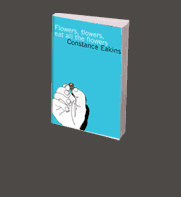“The Fruit Vendor” was Eakins’ first published
work, accepted by the editor of the New Orleans Halfpenny-Post in
1929, when the author was eleven years old. It tells the story
of a young fruit-hawker and the infirm dowager who patronizes
him.
The story
begins with a description of the widow, rolling herself downtown
in her stainless-steel wheelchair at dawn. She does this every
morning, we realize, navigating her way through the bustling
street-market and settling finally, with an atavistic resurgence
of regality, at the pimply boy’s fruit cart. (Being the
newest vendor in the market, the boy must set up his cart in
the back of the lot.) Neither he, nor any of the older, gloom-eyed
vendors can understand the dowager’s
predilection toward him, which creates some difficulties for
the boy. Bashful and cautious in disposition, the novice fruit
vendor has been struggling to assume a modest footing in the
busy—and treacherous—marketplace.
The wealthy dowager’s sudden attention to the boy turns
his competitors vicious, especially once he begins to attract
other buyers, who believe that the dowager must have some good
reason for singling out this boy’s
fruit.
The older vendors’ contempt is mitigated only by
the fact that the dowager, despite her patronage, does nothing
but malign the boy. She chastises him for dropping out of school
and demands that he display his jaundiced nails and oily hair
for her inspection. He has better clean up his act, she says,
for she refuses to buy fruit from anyone of such slovenly sanitary
practices (she ignores the sordid state of his competitors’ hygienic
practices, where pests shuttle freely between oranges and mangy
hands, apples and vermiculated aprons). The boy bears her routine
patiently. He dutifully bags her browned bananas and ripe cantaloupes
with an exaggerated show of care and ties it to the handle of
her wheelchair, and she rolls home with a prissy, delighted look
upon her face.
One morning in early autumn the boy comes down with a terrible
sore throat and cannot bring his fruit cart to the market. When
the crippled widow, loyal to a fault, sees his post vacant, she
suspects the other merchant-thugs of foul play. Loudly refusing
their crude solicitations, she forfeits her daily ration of fruit.
The boy is sick again the next day, and she again refuses fruit,
though less vigorously than before: she has begun to grow wan.
The boy remains in bed for a week, methodically consuming his
entire stock of fruit, fearing that it might rot and go to waste;
the widow dies.
In the story’s final scene, the boy, having
realized the tragic consequences of his greed and insolence (and
having no more fruit to sell), renounces his profession. Emboldened
by a consuming sense of guilt, he delivers a bitter tirade against
the fruit-vendors. “You
lizards, you maggots, you worms!” is the boy’s refrain,
screamed in the middle of the stunned street market, over and
over again, until the grimy, overgrown vendors exact on him the
punishment he craves. |

